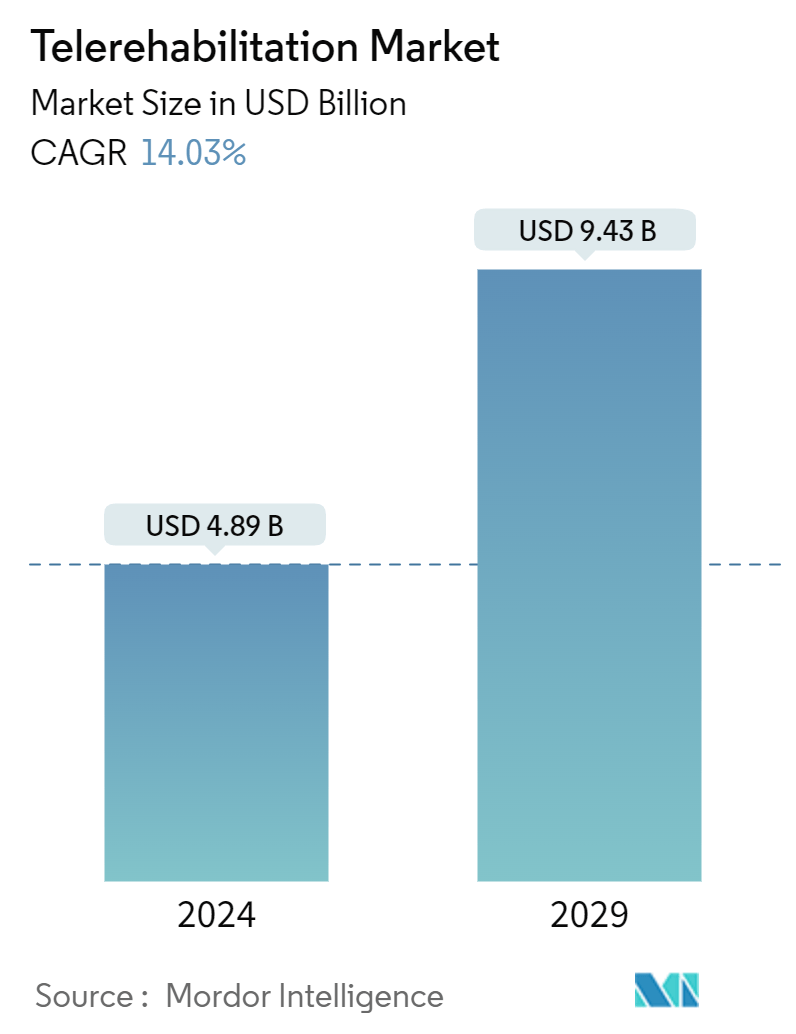Market Size of Telerehabilitation Industry

| Study Period | 2019 - 2029 |
| Market Size (2024) | USD 4.89 Billion |
| Market Size (2029) | USD 9.43 Billion |
| CAGR (2024 - 2029) | 14.03 % |
| Fastest Growing Market | Asia Pacific |
| Largest Market | North America |
| Market Concentration | High |
Major Players
*Disclaimer: Major Players sorted in no particular order |
Telerehabilitation Market Analysis
The Telerehabilitation Market size is estimated at USD 4.89 billion in 2024, and is expected to reach USD 9.43 billion by 2029, growing at a CAGR of 14.03% during the forecast period (2024-2029).
The telerehabilitation market is influenced by multiple factors that are responsible for changing the way healthcare is delivered and accessed. Firstly, the growing prevalence of chronic disorders and musculoskeletal disorders has created a burgeoning demand for rehabilitation services, making telerehabilitation an attractive solution for convenient and continuous care. Secondly, advancements in technology, particularly in telecommunication infrastructure and wearable devices, have enabled real-time monitoring and remote guidance, enhancing the effectiveness of rehabilitation programs. Furthermore, the growing aging population, together with the shortage of healthcare professionals, has influenced healthcare providers to look for telehealth options to reach areas that lack healthcare services.
Telerehabilitation offers convenience to patients who can receive therapy from the comfort of their homes, reducing the need for travel and saving time. According to the article published by the International Journal of Environmental Research and Public Health in April 2022, telerehabilitation has become increasingly prevalent worldwide, particularly in the rehabilitation of geriatric populations, bridging the gap between healthcare professionals and older adults. Thus, telerehabilitation offers significant benefits to geriatric populations by providing convenient access to rehabilitation services from home, reducing logistical barriers, and improving overall patient compliance and outcomes.
Furthermore, according to the World Social Report 2022 by the Department of Economic and Social Affairs of the United Nations, the percentage of people who fall under the age group of 65 years and above is estimated to rise from 10% in 2022 to 16% in 2050 of the total global population. Therefore, factors like the effectiveness of telerehabilitation services for the geriatric population and the growing geriatric population are expected to further contribute to the growth of the market in the coming years.
Apart from this, the continuous improvement in internet connectivity, video conferencing platforms, and mobile devices has made it simpler for healthcare practitioners to deliver telerehabilitation services. High-quality video and audio communication are essential for effective remote rehabilitation. According to one of the articles published by Frontiers in February 2022, tele-exercise studies involving direct or indirect supervision with the use of webcams, video calls, phone calls, and smartphone applications have achieved comparable improvement results compared to the results through in-person rehabilitation from clinics or hospitals. This is expected to be a driving force for the growth of the market during the forecast period.
Therefore, owing to factors such as the rise in the geriatric population and advancements in the telemedicine field, the market is expected to grow during the forecast period. However, factors like privacy and data security concerns and limited patient access to technology can limit the growth of the market in the coming years.
Telerehabilitation Industry Segmentation
As per the scope of the report, telerehabilitation tools refer to a range of technological solutions and tools designed to provide remote rehabilitation services and support to individuals recovering from injuries, surgeries, or medical conditions. The telerehabilitation market is segmented into components, mode of delivery, application, and geography. By component, the market is segmented into software and services and hardware. By mode of delivery, the market is segmented into cloud-based and on-premise. By application, the market is segmented into cardiac rehabilitation, neurological rehabilitation, physiotherapy rehabilitation (orthopedic), cancer, and other applications. The other segments include pediatric rehabilitation and others. By geography, the market is segmented into North America, Europe, Asia-Pacific, the Middle East and Africa, and South America. For each segment, the market sizing and forecasts were made based on value (USD).
| By Component | |
| Software and Services | |
| Hardware |
| By Mode of Delivery | |
| Cloud-based | |
| On-premise |
| By Application | |
| Cardiac Rehabilitation | |
| Neurological Rehabilitation | |
| Physiotherapy Rehabilitation (Orthopedic) | |
| Cancer | |
| Other Applications |
| By Geography | ||||||||
| ||||||||
| ||||||||
| ||||||||
| ||||||||
|
Telerehabilitation Market Size Summary
The telerehabilitation market is poised for significant growth, driven by the increasing prevalence of chronic and musculoskeletal disorders, advancements in telecommunication technologies, and the expanding aging population. Telerehabilitation offers a convenient and efficient solution for delivering rehabilitation services, allowing patients to receive care from the comfort of their homes. This approach is particularly beneficial for geriatric populations, who often face logistical barriers in accessing traditional healthcare services. The market is further bolstered by improvements in internet connectivity and the widespread use of video conferencing platforms, which facilitate real-time monitoring and guidance. Despite challenges such as privacy concerns and limited access to technology, the telerehabilitation market is expected to expand, with physiotherapy rehabilitation (orthopedic) emerging as a dominant segment due to the high burden of musculoskeletal disorders and ongoing research validating its effectiveness.
The Asia-Pacific region is anticipated to experience substantial growth in the telerehabilitation market, fueled by a rising elderly population, increased cancer cases, and the adoption of digital technologies for rehabilitation. The launch of telerehabilitation services and software, such as OpenTeleRehab in Vietnam, has significantly impacted market expansion in this region. Key players in the market, including American Well, Koninklijke Philips NV, Tunstall Group, Teladoc Health Inc., and Hinge Health Inc., are forming partnerships with healthcare providers and institutions to enhance their service offerings and integrate into existing healthcare systems. These collaborations, along with ongoing research and development activities, are expected to drive the market's growth, particularly in Asia-Pacific, where the incidence of cancer and the demand for innovative rehabilitation solutions are on the rise.
Telerehabilitation Market Size - Table of Contents
-
1. MARKET DYNAMICS
-
1.1 Market Overview
-
1.2 Market Drivers
-
1.2.1 Burden of Chronic Diseases and Growing Geriatrics Population
-
1.2.2 Advantages and Convenience Associated with Telerehabilitation
-
1.2.3 Advancements in Telemedicine Technology and Launch of Telerehabilitation Services
-
-
1.3 Market Restraints
-
1.3.1 Limited Patient Access to Technology
-
1.3.2 Privacy and Data Security Concerns
-
-
1.4 Porter's Five Forces Analysis
-
1.4.1 Threat of New Entrants
-
1.4.2 Bargaining Power of Buyers/Consumers
-
1.4.3 Bargaining Power of Suppliers
-
1.4.4 Threat of Substitute Products
-
1.4.5 Intensity of Competitive Rivalry
-
-
-
2. MARKET SEGMENTATION (Market Size by Value - USD)
-
2.1 By Component
-
2.1.1 Software and Services
-
2.1.2 Hardware
-
-
2.2 By Mode of Delivery
-
2.2.1 Cloud-based
-
2.2.2 On-premise
-
-
2.3 By Application
-
2.3.1 Cardiac Rehabilitation
-
2.3.2 Neurological Rehabilitation
-
2.3.3 Physiotherapy Rehabilitation (Orthopedic)
-
2.3.4 Cancer
-
2.3.5 Other Applications
-
-
2.4 By Geography
-
2.4.1 North America
-
2.4.1.1 United States
-
2.4.1.2 Canada
-
2.4.1.3 Mexico
-
-
2.4.2 Europe
-
2.4.2.1 Germany
-
2.4.2.2 United Kingdom
-
2.4.2.3 France
-
2.4.2.4 Italy
-
2.4.2.5 Spain
-
2.4.2.6 Rest of Europe
-
-
2.4.3 Asia-Pacific
-
2.4.3.1 China
-
2.4.3.2 Japan
-
2.4.3.3 India
-
2.4.3.4 Australia
-
2.4.3.5 South Korea
-
2.4.3.6 Rest of Asia-Pacific
-
-
2.4.4 Middle East and Africa
-
2.4.4.1 GCC
-
2.4.4.2 South Africa
-
2.4.4.3 Rest of Middle East and Africa
-
-
2.4.5 South America
-
2.4.5.1 Brazil
-
2.4.5.2 Argentina
-
2.4.5.3 Rest of South America
-
-
-
Telerehabilitation Market Size FAQs
How big is the Telerehabilitation Market?
The Telerehabilitation Market size is expected to reach USD 4.89 billion in 2024 and grow at a CAGR of 14.03% to reach USD 9.43 billion by 2029.
What is the current Telerehabilitation Market size?
In 2024, the Telerehabilitation Market size is expected to reach USD 4.89 billion.

